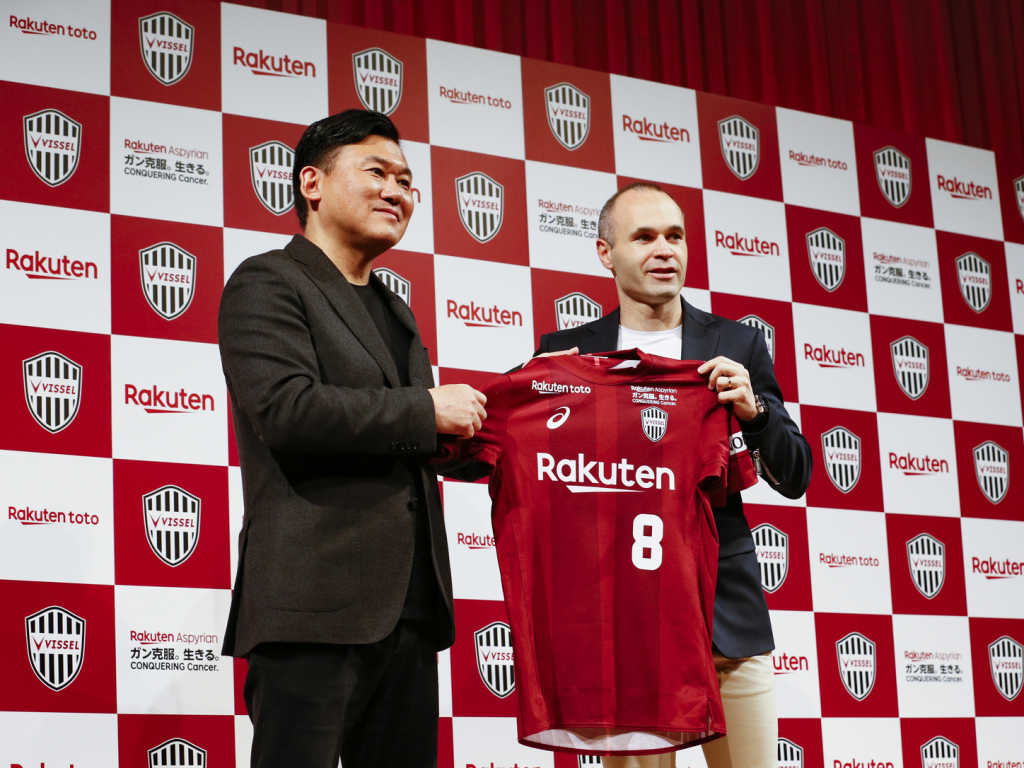Vissel Kobe this week announced the signing of former Barcelona captain Andrés Iniesta in what is far and away the biggest J-League transfer in more than two decades. It was initially thought that the midfielder would be heading to the Chinese Super League (CSL), where many big-name players have gone in recent years, but he has instead chosen to join former Arsenal forward Lukas Podolski in the western Japanese port city.
“I received offers from other clubs and I would like to thank them,” Iniesta said at a press conference in Tokyo yesterday. “I chose Vissel Kobe because the project that has been presented to me is very interesting. They showed a lot of trust and confidence in me as a player and a person.”
The diminutive midfielder was also highly complimentary about the country and the football that is played here.
“I’m excited to play. Japan is a great country. I like everything about the place, especially the people”
“I’ve watched the J-League and the Japan national side,” he continued. “The players are smart and technical. I’m excited to play. Japan is a great country. I like everything about the place, especially the people. The most important thing is to immerse myself in the culture. My family and I would like to become members of the community.”
Hiroshi Mikitani, meanwhile, couldn’t hide his excitement as he announced the transfer. The Vissel Kobe owner, who is also the chief executive of Barcelona’s main sponsor Rakuten, said Iniesta “played the most beautiful football in the world.” He went on to speak about the Spaniard’s global appeal and the impact he expects him to make, not only for his own side, but the league in general. Japanese football expert Sean Carroll concurred.
“It’s a huge move as it shows the J-League is able to match the CSL when it comes to capturing big names,” the British journalist told TW. “This could act as an incentive to other foreign players to follow suit and also Japanese clubs to try their hand at picking up top level players approaching the end of their careers (as we’re also seeing with Sagan Tosu reportedly very close to signing Fernando Torres).
“Whether it has an impact on the pitch remains to be seen, but in terms of aiding the image of the league and also helping young, local players at those clubs it can only be seen as a good thing.”
A Midfield Maestro
Iniesta joined Barcelona’s famed La Masia Academy at the age of 12 after impressing at a junior seven-a-side tournament. A shy boy from the tiny village of Fuentealbilla in the Spanish province of Albacete, he was in floods of tears as he parted from his parents.
It took the youngster a while to settle at the academy, but once he did there was no stopping him. At the 1999 Nike Premier Cup, the then 14-year-old scored the winning goal in the final and was named Player of the Tournament in front of a watching Pep Guardiola. The current Man City manager, who coached Iniesta during Barcelona’s golden years between 2008 and 2012, later reportedly told fellow midfielder Xavi, “You will retire me, but this kid will retire us both.”
Domestic Dominance
A few years later Xavi and Iniesta would form the most formidable midfield partnership in world football. Brilliantly marshalled by Sergio Busquets, the pair provided the bullets for the little genius Lionel Messi as La Blaugrana dominated in Spain and won several trophies on the continent playing some of the best football the world has ever seen.
Many of Iniesta’s finest moments for the club were in the UEFA Champions League. In the 2006 final he came off the bench to inspire Barcelona as they overturned a one goal deficit to defeat Arsenal 2-1. Three years later his dramatic last-minute winner against Chelsea earned his side a place in the 2009 final where they would play Man Utd. Barca were far too strong for their opponents in the final with Xavi and Iniesta running rings around the Red Devils’ midfield. They won the game 2-0 and after the match Wayne Rooney labelled Iniesta as the best player on the planet.
The midfield genius went on to win two more UCL titles in 2011 and 2014. During his 16 years in the Barcelona first team, he also picked up nine La Liga titles, six Copa Del Ray trophies, seven Spanish Cups, three Club World Cups and three European Super Cups, making him one of the most decorated footballers of all time.
That Goal
On the international front, he was also part of the most successful Spanish side in the country’s history, lifting two European Championships and a World Cup. Instrumental to the side’s success, he was named “Player of the Tournament” at the 2012 Euros in Poland and Ukraine. His crowning moment, though, came in 2010 when he fired home the extra-time goal that won the World Cup for Spain against Holland.
Leading up to the South Africa World Cup, he’d had a number of injury setbacks and suffered psychologically following the death of his close friend and former youth international teammate Daniel Jarque, who was just 26 when he suffered a heart attack during a preseason tour for his club RCD Espanyol.
After his goal against the Dutch, Iniesta took off his Spain jersey to reveal a white T-shirt with the message, “Dani Jarque siempre con nosotros” (“Dani Jarque, always with us”). Watching on a TV screen over 10,000 miles away was Jarque’s wife Jessica. It was the first time she had been able to watch a game since the death of her husband 11 months earlier.
“He was in Johannesburg and I was in Castelldefels, but I just knew he was going to score that goal. I just knew it,” she said in an extract taken from the book The Artist: Being Iniesta. “There are some things that you just can’t explain. It is like when you love someone completely, there is always a connection that goes deeper than the physical. I don’t know what it is, but there is something more.”
Transcending Club Rivalries
Following that goal, Iniesta was always warmly received at the RCDE stadium by fans of RCD Espanyol, Barcelona’s local rivals. For the past few seasons he has been the only La Blaugrana player to get a positive reception at their ground, and this year a banner was held up by Espanyol supporters saying, “Thanks Iniesta, for being a friend above everything else.”
“Universally respected, there are few, if any, players in the game who transcend club rivalries quite like Iniesta”
Universally respected, there are few, if any, players in the game who transcend club rivalries quite like Iniesta. He remains one of only three Barcelona stars (along with Diego Maradona and Ronaldinho) to have received a standing ovation from Real Madrid fans at the Bernabeu Stadium. Los Blancos’ players have regularly spoken about their admiration for the former Barcelona man, including captain Sergio Ramos who recently said that he would have won two Ballon D’Ors had he been called “Andresinho.”
The award voted for by journalists, which is handed out to the outstanding male player over a calendar year, has been shared between Lionel Messi and Cristiano Ronaldo (both winning five times) since 2008. France Football, the publication in charge of handing out the trophy, this year apologized for overlooking Iniesta.
“Forgive us Andrés,” wrote the magazine’s editor Pascal Ferre. “For us, he wasn’t just a player, he was the player. His sacrifices for the team ultimately deprived him of greater individual recognition. Of all the absences on the list of Ballon D’Or winners, his is particularly painful.”
A New Chapter
For the player himself it probably isn’t that painful. As Ferre mentioned, Iniesta’s focus is always on the team. This summer he will try to help his country reclaim the World Cup in Russia and then following a short break will turn his attention to Vissel Kobe who currently lie sixth in the table.
It will be interesting to see how much of an impact the 34-year-old has. Not since the beginning of the J-League, when the likes of Zico and Gary Lineker arrived on these shores, has there been this much excitement about a transfer. Last year Kobe made a big statement of intent with the capture of World Cup winner Lukas Podolski. Their latest signing, however, feels even more significant.
“I think the signings of Podolski and Diego Forlan [who joined Cerezo Osaka in 2014] were similar in a way, but in both those cases the players hadn’t come directly from a top-level club,” says Carroll. “In Iniesta’s case, he has come from a huge team, in fact the biggest club in the world. What Vissel and other clubs need to do now, though, is learn how to use these players. With Forlan and Podolski there was a sense of just expecting them to win games on their own and that isn’t how it works.”









